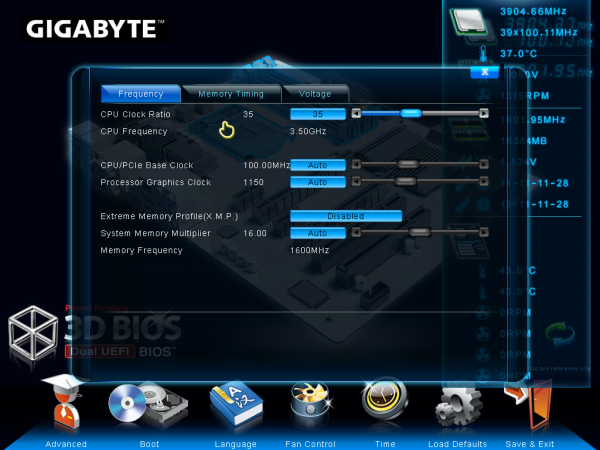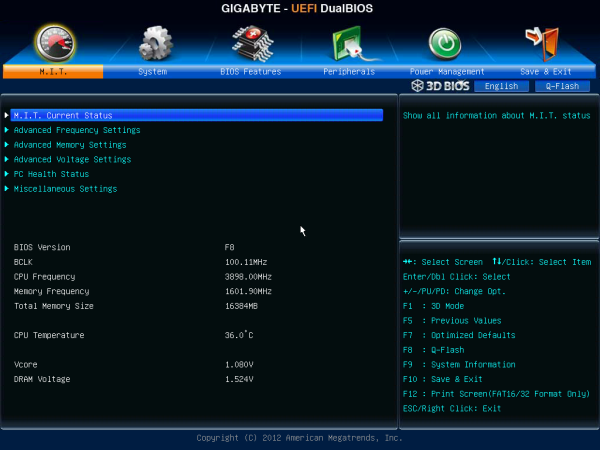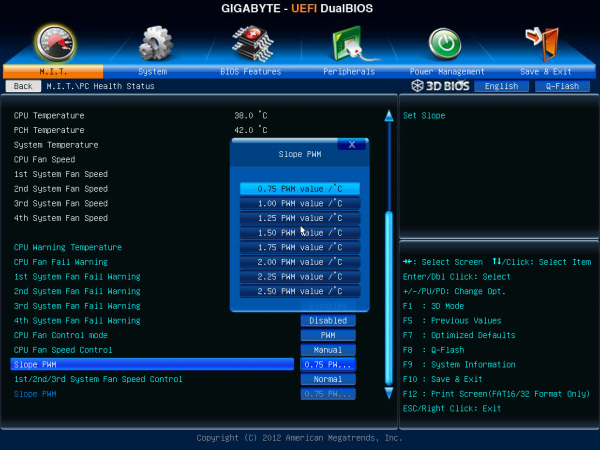Gigabyte GA-Z77X-UD5H Review: Functionality meets Competitive Pricing
by Ian Cutress on July 25, 2012 5:00 AM EST- Posted in
- Motherboards
- Gigabyte
- Z77
Gigabyte GA-Z77X-UD5H BIOS
As of late, I have been critical of the Gigabyte BIOS system. Their 3D BIOS implementation of a graphical UEFI used to be very slow to respond, and as a result made it a pig to navigate. Fast forward on a generation and our 3D BIOS is super fast, highly responsive, and more of a pleasure to use. The 3D BIOS philosophy is a little odd, as the only thing 3D about the BIOS screen is the perspective - it is still a 2D image but at an oblique angle.
The front screen of the Gigabyte BIOS uses this oblique image to act as a clickable interface for different parts of the motherboard. Users can select the CPU, the memory, the rear IO, the PCIe, the SATA connectors or the chipset in order to bring up a separate menu containing several advanced options for that area of the motherboard. This unfortunately falls down on a few areas:
Should a non-enthusiast user have this system as part of a pre-built computer (for example, my parents) and need to enter the BIOS, they will not know what to click as they do not understand what a motherboard is. I would not be able to explain 'click the SATA ports' as they do not know what SATA ports are. What we could do with here is some hover text over each part to explain what each part is in non-technical language.
In addition, as an enthusiast, my main priority of a BIOS is to manipulate and diagnose. The first screen I should see should have all the important information on it - the motherboard I am using, the CPU installed, the speed of the CPU (voltages and temperatures would be handy), the memory size, the memory speed, and other relevant data (boot sequence, hard drives). With a screen like 3D BIOS, some of this information is available straight away, and some is provided when the oblique image is clicked (see image below) but is covered by the menu brought up. For the real information, I will need to navigate through separate menus. There is enough leeway with a UEFI to be able to cater to both the enthusiast and the non-technical; it is just a shame that motherboard manufacturers still cannot get it right.
In the advanced menu, the first screen we come to is the M.I.T (Motherboard Intelligent Tweaker?). This has some valid information to greet us - BIOS version, CPU speed and voltage, memory size, frequency and voltage, and CPU temperature. The 'Current Status' option provides a longer list of exact settings, helpful for diagnosis.
Overclock options are found throughout several menus: CPU clocks and ratios are adjusted in "Advanced Frequency Settings"; memory timings and straps can be changed in "Advanced Memory Settings"; and anything relating to voltages or the 3D Power delivery options are found in "Voltage Settings". It does confuse me a little, as motherboard manufacturers have this overwhelming tendency to put options in one place only. The BIOS should be a tool that is easy to use, so why not put the voltage options for the CPU in with the CPU clocks and ratios? Or 3D Power options related to a CPU in a sub-menu in the Frequency options? The only motherboard manufacturer who is not using what is essentially a basic text and option interface right now is Intel on their own motherboards, so it does strike me as strange that no-one else is doing it.
Fan options in the BIOS are found in the M.I.T. -> PC Health Status menu, located at the bottom. Gigabyte fan controls are limited at best, especially when you compare them to the best in the motherboard arena - users here have to try to understand the options provided. The units PWM value / ºC mean nothing to everyone. Some sort of system needs to be devised here which users can input temperatures when they want the fans to idle and when they want the fans to be at 100%, and the BIOS calculates the appropriate 'PWM value/ºC' to select.
Despite my critical analysis of the Gigabyte BIOS, I found it easy to navigate by the arrow keys (my preferred method) and type in values during overclocking. It is a big step up from the first iterations of Gigabyte's 3D BIOS for sure.




















70 Comments
View All Comments
Aunt Fritzi - Wednesday, July 25, 2012 - link
I have a 3-year-old Biostar motherboard (go ahead and laugh)... it has two PS/2 ports. A PS/2 keyboard is needed to bring up the BIOS tool at startup. Is that generally the case when mobos have PS/2 ports?Samus - Thursday, July 26, 2012 - link
You need to enable "USB Legacy Keyboard" in the BIOS, and your USB keyboard will work.Samus - Thursday, July 26, 2012 - link
PS/2 has a limitation of 5 keystrokes within 250ms of each other.The ultimate test is Stepmania (DDR) where you hit many, many keys at the same time.
PS/2 is a joke for gaming or fast typing. It has no place in modern computing.
Questor - Tuesday, July 31, 2012 - link
My wife can type like lightning and mistake free. It astounds me to watch her. I made the switch from PS/2 to buying USB keyboards some years ago, she has been blowing my mind with them without missing a beat since the switch.I am not half-bad at typing and have neither of us have noticed a difference.
I am not saying you are wrong, I am just saying, we have not noticed any issues.
Einy0 - Wednesday, July 25, 2012 - link
PS/2 is dead long live USB!!!Belard - Thursday, July 26, 2012 - link
For my 1996 keyboard, the ps/2 port is a must. They don't make them like they used... my $20 keyboard is easily better made than todays $20~80 keyboards.Really, todays keyboards from MS and Logitech and most others use stickers for for the keys and have weak support. Mine is solid, heavy and will hopefully last another 10 years.
Most PS/2>USB adapters don't work.
Grok42 - Wednesday, July 25, 2012 - link
I guess I'll be the lone supporter of ps/2 as well. I haven't found a replacement for my $20 IBM KB-8923 ps/2 keyboard. I don't even consider myself a picky keyboard guy either. I don't want a cheap light piece of junk that moves around my desk as I type and I don't want some 10lb monster clickty clackety old school keyboard either. Most importantly, I like to keep the number of "shopping" and "email" buttons to a minimum. Seems that's an impossible list of needs these days.Of course, it might be possible to use this ps/2 keyboard with a ps/2 to USB converter but I haven't tried.
Belard - Thursday, July 26, 2012 - link
That IO panel is full of ports. If you need ps/2, go for a lower-end Gigabyte board. Their Z77 boards start at about $125 (or $80 in Dallas) and have ps/2 connectors.For my 1996 keyboard, the ps/2 port is a must. They don't make them like they used... my $20 keyboard is easily better made than todays $20~80 keyboards.
johnrysf - Saturday, August 4, 2012 - link
Before ya'll plunge off the road and into the weeds in the typing speed, etc. discussion that follows, let me mention that I have 2-3 ps/2 <---> USB pigtails that I've picked up free over the years. They're maybe 8" long. Perhaps this will offend your PC-related aspirations, but one of them even says "Radio Shack" on it.Life really is short. Geez.
Nickel020 - Wednesday, July 25, 2012 - link
First, nice review! I like the more in-depth single board reviews!You always point out the software situation with GB boards. While this is definitely an issue as far as fan controls goes, as far as overclocking goes, there's also the GB Tweak Launcher:
http://gigabytedaily.blogspot.de/2012/04/gigabyte-...
While not looking pretty, I actually prefer this functionality focussed UI to a fancy one (while I like the Asus UI, the clicking does get a little bit tedious when trying a lot of different settings). I don't know whether you're not aware of this software, or don't mention it for another reason, but I think you should include it in the review. Or at least mention it, so people are aware of it.
Another point is the voltage read points, which you don't mention in the review as well. I think these are actually a major selling point for overclockers, and should be mentioned, if not even used to check actual voltages versus BIOS settings. That's also an issue that I have with your UD3H/GD65 etc. review: You say that the GD65 gains voltage read points over the UD3H, yet the UD3H *has* voltage read points (even though I like MSI's implementation far better than what Asus/GB are doing).
http://www.anandtech.com/show/5793/intel-z77-mothe...
That's it for now, I'll read the complete review now :)